Mushrooms. The first image that comes to mind is the spore-bearing, dusty, umbrella-shaped fungi that are poisonous and harmful to humans or animals.
But not all mushrooms are bad and dangerous. In fact, only 3% of mushroom species are known to be poisonous. The others are non-poisonous, and 10% of these mushrooms are edible and beneficial.
In this article, we have listed 22 types of mushrooms that are famous all around the world. Most of these mushroom species can be eaten raw and add flavor to many dishes.
Table of Contents
1. Black Truffle Mushrooms (Tuber melanosporum)

Also known as the black Perigord truffles, these fungi are known to be one of the most expensive mushrooms in the world. They cost around $330 per pound.
There are two types of truffles: black and white. Black truffles hail from France, specifically in the mountainous regions of Southern France, while the white ones originate in Italy.
Black truffles yield an earthy aroma and could be served with pasta or sliced thinly before sprinkling them over risotto and steak.
The reason that black truffles are so expensive is their availability. They are an extremely scarce commodity that only grows successfully in the wild. Commercial growers have found it almost impossible to cultivate this variety.
2. Shiitake Mushrooms (Lentinula edodes)
Shiitake mushrooms are native to China, Korea, and Japan. These mushrooms are also known as black forest mushrooms, golden oak mushrooms, oakwood mushrooms, and sawtooth oak mushrooms. They grow in the moist, decaying wood of deciduous trees.
Shiitake mushrooms produce meaty and smoky flavors. Oftentimes, they are added to different sauces and soups as additional flavorings. If you’re looking to get the most flavor out of these mushrooms, opt for the dried ones.
Shiitake mushrooms are beneficial to our bodies due to a specific chemical called lentinan that helps in boosting the immune system.
3. Porcini Mushrooms (Boletus edulis)
These mushrooms can easily be recognized by their thick, brown cap and sturdy, white stalk. They are commonly found in northern hemisphere forests, particularly in Italy, North America, and Asia.
Porcini mushrooms are also known as the king bolete, cep, Steinpilz, or penny bun mushrooms.
Due to their meaty, nutty, and earthy aromas, Porcinis are widely used in different recipes including rice dishes, broth, beef dishes, soups, sauces, risotto, and Italian pasta.
These mushrooms can grow up to 12 inches wide and weigh around 2.2 pounds!
4. Portobello Mushrooms (Agaricus bisporus)
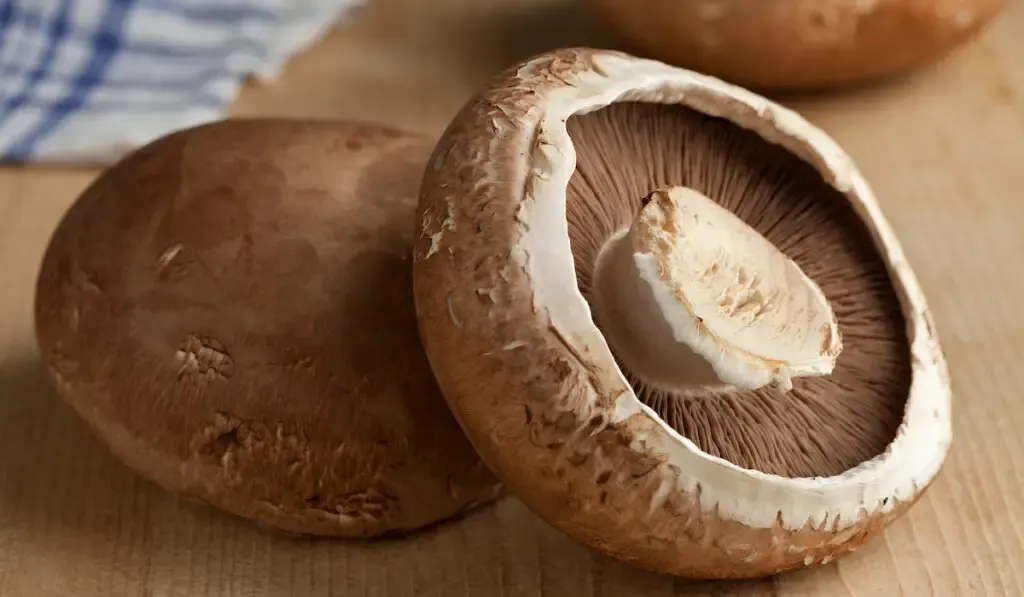
Portobello mushrooms are native to Europe and North America.
In 1707, they were first cultivated by a French botanist named Joseph Pitton de Tournefot. These mushrooms were discovered by farmers in Pennsylvania in 1926 before being marketed commercially by Whole Foods and Natural Foods in 1980.
Portobello mushrooms offer smokey and earthy flavors. With their meaty and chewy texture, you can find these mushrooms being used to replace meat in many vegetarian dishes. They also taste delicious when being grilled or stuffed with other food.
5. White Button Mushrooms (Agaricus bisporus)
These small to medium-sized mushrooms are actually portobello mushrooms, they are just harvested at an earlier stage.
They make up around 90% of mushrooms consumed in the United States. White button mushrooms are native to Europe and North America. They are also known as table mushrooms, Champignon de Paris, and common mushrooms.
Due to their mild and earthy flavor, these mushrooms go well in many recipes. They can also be cooked in many ways including grilling, stewing, roasting, baking, and even sautéing.
6. Cremini Mushrooms (Agaricus bisporus)
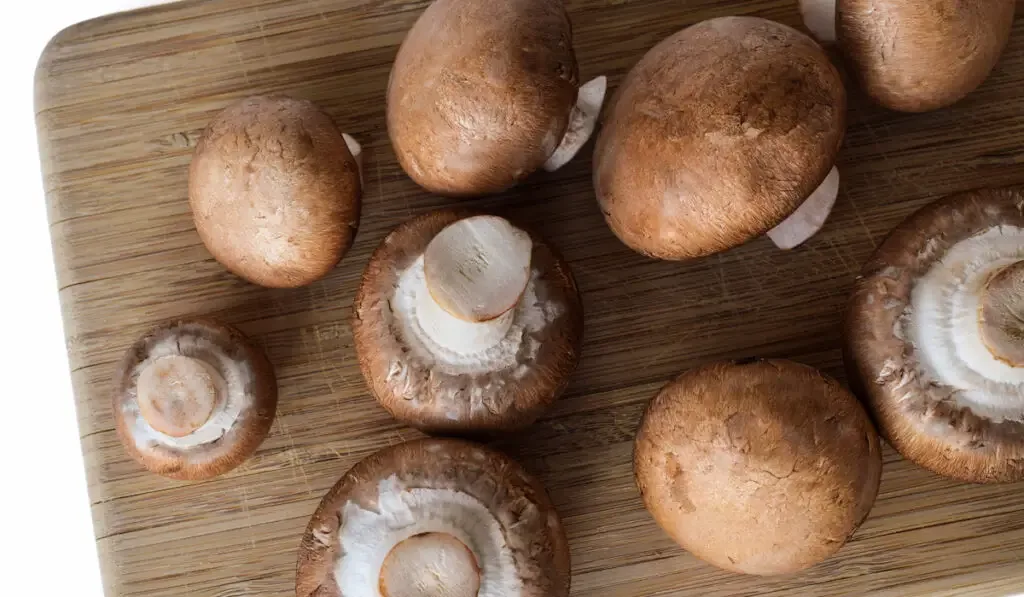
Cremini mushrooms are similar to white button mushrooms. The only difference is that they are more mature than the regular white buttons. These mushrooms are also known as brown mushrooms, baby bellas, and golden Italian mushrooms.
Like white buttons, creminis are round in shape with brown caps and thick stems. They taste earthy and savory but slightly milder than other varieties. Due to their low-water content, these mushrooms are slightly meaty and chewy.
Creminis can be prepared in many ways including roasting, baking, sautéing, and grilling. They go well with rice and noodle dishes.
7. Matsutake Mushrooms (Tricholoma matsutake)
Also known as pine mushrooms, the Matsutakes are top-tier, edible mushrooms appreciated by most people in China, Japan, and Korea. These mushrooms can also be found in North America and the western part of the United States.
In the wild, they grow under specific trees and can be quite hard to find. Hence, they are highly prized for their scarcity.
In Japan, the highest grade of Matsutakes can reach up to $455 per pound, but imported ones are sold at around $41 per pound. These mushrooms yield a unique spicy aroma with a meaty texture.
8. Black Trumpet Mushrooms (Craterellus cornucopioides)
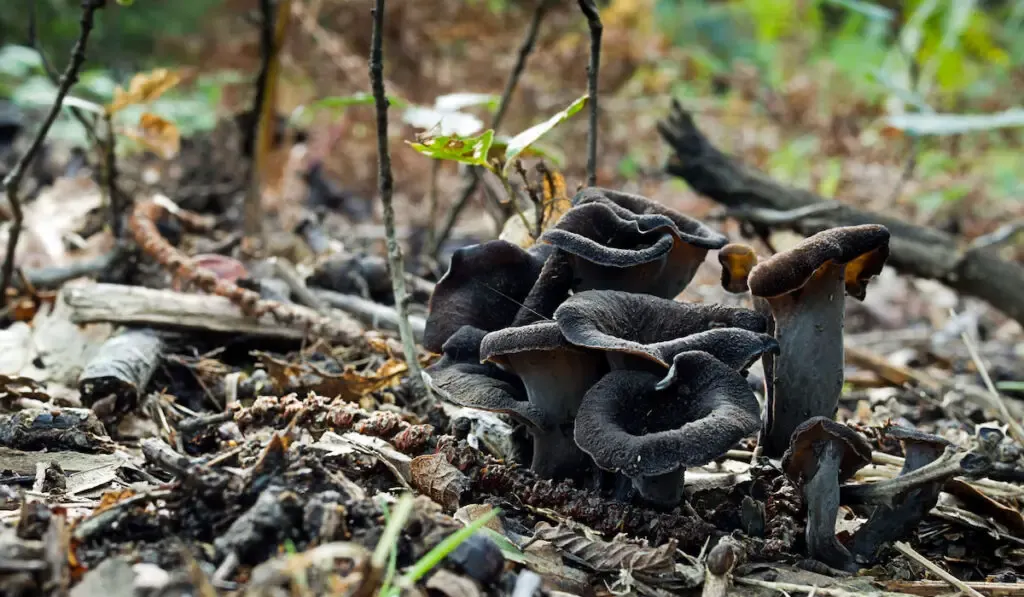
Black trumpet mushrooms are commonly found in Europe, East Asia, and North America. They also go by other names such as Trumpet of The Dead, the Black Chanterelle, and Horn of Plenty.
These funnel-shaped mushrooms can grow up to 4 inches tall and 0.15 to 2.75 inches wide.
Although they don’t look too appealing, the black trumpets are a non-poisonous variety. They have a chewy texture with a sweet, woody aroma and smoky flavor.
Aside from being black, these mushrooms can also be found in gray and brown colors. They also grow sporadically in mossy regions and on the floors of hardwood forests.
9. Shimeji Mushrooms (Lyophyllum shimeji)
Also known as the beech mushrooms, these edible fungi are native to East Asia and Northern Europe, but are widely cultivated in North America.
They are easily recognized by their small rounded caps and long stalks. Shimeji mushrooms come in different varieties but the two most common ones are white shimejis and brown shimejis.
Due to their bitter taste, these mushrooms aren’t suitable to be consumed raw. But when cooked, they yield a rich nutty and umami flavor. This is because of the high concentration of amino acids known as glutamates found in these mushrooms.
10. Enoki Mushrooms (Flammulina velutipes)
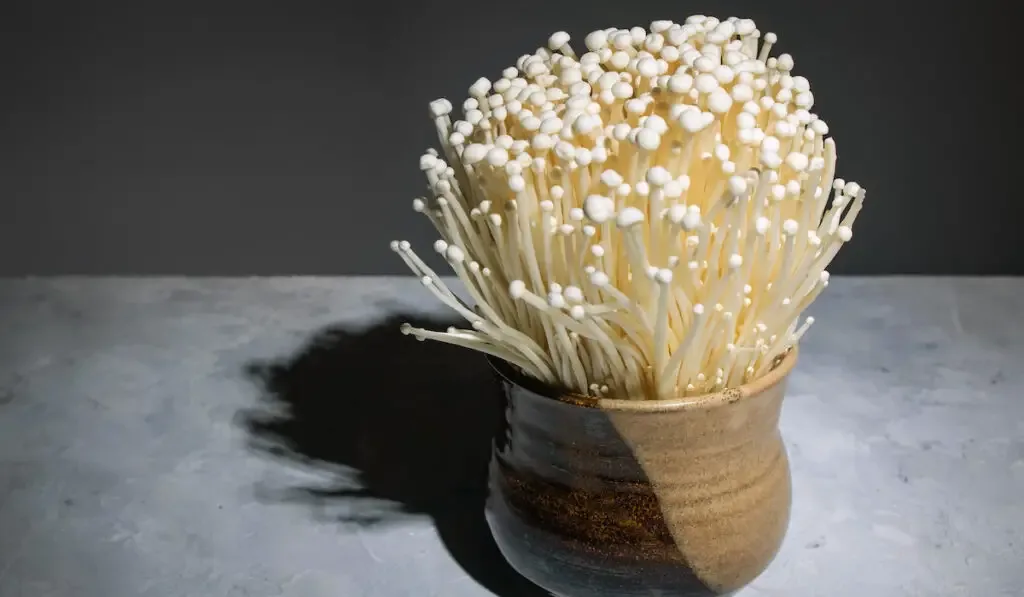
Enoki mushrooms are sold worldwide because they are commonly used in many Asian cuisines. They are also called “enokitake”.
These mushrooms originated in Japan and can be found growing on stumps of different trees including persimmon, ash, mulberry, and Chinese hackberry trees.
Enoki mushrooms possess small and shiny caps with long stalks. Wild enokis are usually brown, while cultivated ones are generally white in color.
These mushrooms produce a mild, fruity, nutty flavor with a meaty texture. They can be mixed with many dishes such as soups, stews, rice and noodle dishes, curries, hot pots, and stir-frys.
11. Maitake Mushrooms (Grifola frondosa)
Also known as the hen-of-the-woods or sheep’s head, these mushrooms can be found in Japan, China, Europe, and North America. They are also widely cultivated in the northeast United States and start growing in the late summer.
Maitake mushrooms can be recognized by their cabbage-like shape with feathery brown caps that overlap each other.
These mushrooms produce a mild but earthy flavor and can be used to create a complex but savory taste in food.
Maitakes also offer many benefits to our health. For instance, they can be incorporated into our diet to help reduce cholesterol levels, lower blood glucose levels, and boost the immune system.
12. King Oyster Mushrooms (Pleurotus eryngii)
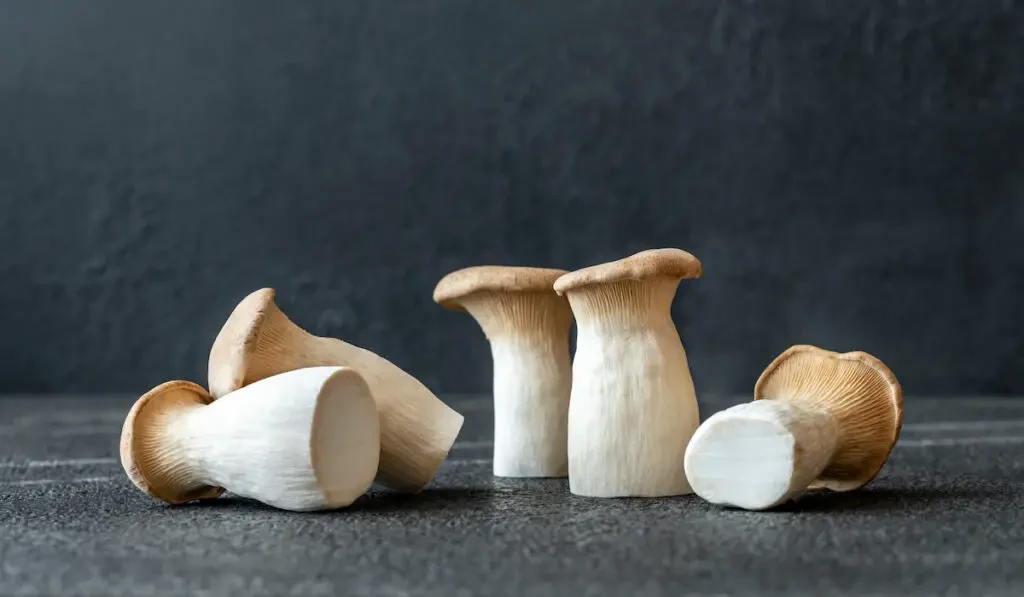
Being the largest species of oyster mushrooms, these medium-to-large-sized mushrooms can be distinguished by their large, wide caps and thick stalk.
They are native to many regions including Asia, Europe, North Africa, and the Middle East.
King oyster mushrooms are rich in earthy, nutty, and umami flavors. Due to their meaty and chewy texture, eating these mushrooms is similar to that of chewing on abalones.
King oyster mushrooms can be served and added into different recipes including soups, stews, pasta, meatballs, casseroles, and more. However, it isn’t advisable to eat them raw due to the metallic taste that can only be removed through cooking.
13. Green-Cracking Russula Mushrooms (Russula virescens)
From afar, these mushrooms might look dangerous but they aren’t poisonous. In fact, they are edible and beneficial to our health.
Green-cracking russula mushrooms can be found in Europe, Asia, Central America, and North Africa. They are also considered as one of the famous edible mushrooms in China and Spain.
These mushrooms can be recognized by their unique, pale green caps that can grow up to 6 inches wide. You can also find irregular dark green patches on the surface of the caps.
Green-cracking russulas yield a mixed taste between earthy, nutty, and sweet. They can be grilled, roasted, stewed, sautéed, or consumed raw.
14. Red Pine Mushrooms (Lactarius deliciosus)

Originating from the southern Pyrenees, red pine mushrooms are one of the best-known members of the large milk-cap genus, Lactarius. But they were accidentally introduced to other parts of the world including Canada, Australia, Chile, New Zealand, and the United States.
Red pine mushrooms are also known as Saffron milk cap mushrooms. They can be recognized by their reddish-orange skin and convex-shaped caps that grow up to 5.5 inches wide.
Due to their slightly bitter and mild taste, these mushrooms shouldn’t be eaten raw. But they can be served in different ways including stewed, sautéed, grilled, marinated, or just cooked with butter.
15. Morel Mushrooms (Morchella)
These wild mushrooms are native to Europe and North America. In the United States, they are known by the locals as Hickory Chickens or Dry Land Fish, particularly in areas such as Michigan, Virginia, and Kentucky.
Morels can be recognized by their brown, cone-shaped bodies, and a honeycomb-like texture on their skin. There are different varieties of morels but the two most common ones are yellow morels and black morels.
Morels yield a nutty and earthy flavor. The darker their skin gets, the nuttier, smokier, and earthier their flavor gets.
16. Hedgehog Mushrooms (Hydnum repandum)
Commonly known as the wood hedgehog or sweet tooth, these mushrooms received their name from the spiky gills underneath their caps that resemble hedgehogs.
They can be commonly found in Europe, eastern and western North America, southern China, and Japan.
Hedgehog mushrooms are mycorrhizal and grow in shelve-like patterns on trees. These small-to-large-sized fungi can be recognized by their thin, convex-shaped caps and white stalks. The caps come in different colors including white, salmon pink, and whitish-yellow.
These mushrooms yield a mix of nutty, earthy, fruity, and peppery flavors with a chewy texture. They can be grilled, roasted, sautéed, baked, or even boiled in soups and stews.
17. Parasol Mushrooms (Macrolepiota procera)

Also known as the Snake’s Sponge or Snake’s Hat mushrooms, these fungi are native to Europe and North America but can also be found in temperate regions such as Australia and New Zealand.
These medium-to-large-sized mushrooms can be recognized by their cone-shaped caps that grow wide, looking like umbrellas when they mature. You can also find flaky, dark brown scales on their caps.
Some poisonous mushrooms are similar to Parasols. So, consult an expert before you forage for this species.
Parasol mushrooms have a soft texture with a nutty and umami flavor. They are used in many dishes including soups, stews, mixed omelets, stir-fried foods, rice, and noodle dishes, as well as baked into pies.
18. Lion’s Mane Mushrooms (Hericium erinaceus)
Lion’s mane mushrooms are commonly found in Asia, Europe, and North America. They are also called the smart mushrooms, bearded tooth fungus, or mountain-priest mushrooms. But in Asia, they are known as yamabushitake or hou tou gu.
These large mushrooms are fairly unique to their overall shape that resembles a lion’s mane. This “mane” is actually the gills that grow outward, looking like long, drooping teeth.
Lion’s manes yield a lobster-like flavor that is considered unique to some chefs and restaurant owners.
Lion’s manes are also considered superfoods due to their medicinal benefits that can help protect the stomach wall lining. They can also aid the nervous system, reducing inflammation, as well as treating anxiety.
19. Chanterelle Mushrooms (Cantharellus cibarius)
Chanterelle mushrooms are one of the popular mushroom varieties found in Europe and North America.
Due to their cup-like and funnel-shaped caps, these mushrooms received their name from the Greek word “kantharos” meaning “cup” or “tankard”.
Chanterelles usually come in a mix of yellow, orange, and white colors. In the culinary world, these mushrooms are highly prized due to their complex flavors that consist of subtle hints between black pepper, apricot, and butter.
Due to their savory aromas, chanterelles also are used to enhance the flavors in soups, stews, souffles, sauces, and many other dishes. To pick the tastiest and freshest chanterelles, find the ones that yield a peach or apricot-like odor and have a golden color and firm texture.
20. Wood Blewit Mushrooms (Clitocybe nuda)
Wood blewit mushrooms are native to Europe and North America. They can be recognized by their wide caps, thick stalk, and pink spores. The color of the caps ranges from blue-lilac to violet-tinged.
For some people, consuming these mushrooms can trigger allergic reactions even if the mushrooms are cooked.
Overall, wood blewits are edible and non-poisonous. They can be mixed in butter, sauces, stews, or used as omelet fillings.
21. Reishi Mushrooms (Ganoderma lingzhi)
Also known as Lingzhi, these kidney-shaped mushrooms were first discovered 2,000 years ago by Chinese medical practitioners in Changbai Mountains.
Today, these mushrooms can be found in many places including Europe, North America, and Asia.
Reishi mushrooms can be distinguished by their shiny, brown fan-shaped caps and short stalk. They generally grow the bark of deciduous trees but can be cultivated on sawdust, hardwood bark, and wood chips.
Reishi mushrooms are known to carry many medicinal benefits such as boosting the immune system, enhancing cardiovascular health, and more.
22. Yellow Knight Mushrooms (Tricholoma equestre)
Yellow knight mushrooms are also known as the Man on Horseback. These wild mushrooms originated in Germany but can also be found in France and Central Portugal.
Yellow knight mushrooms can be recognized by their chunky size, wide brownish-yellow caps, and thick stalks.
Yellow knight mushrooms are considered hazardous to eat. In the 1990s, there were several cases of people who suffered acute poisoning after ingesting them.
Final Thoughts
Most of the mushroom species listed above offer a lot of nutrients and benefits to our health. There is no reason why you can’t incorporate these fungi as a part of your healthy diet. They are rich in protein, antioxidants, fiber, niacin, and folate.
As long as you avoid the magic mushrooms and poisonous species — always consult expert advice if you’re foraging for mushrooms — you can consume the edible, non-poisonous mushrooms in any way, shape, or form.
Resources
- https://cleangreensimple.com/article/different-types-of-mushrooms/
- https://www.gardeningchannel.com/list-of-mushroom-types-from-a-to-z/
- https://grocycle.com/types-of-mushrooms/
- https://www.epicurious.com/ingredients/how-to-buy-and-store-different-types-of-mushrooms-recipes-article
- https://myfoodbook.com.au/tips/12-different-types-of-mushrooms
- https://www.bbcgoodfood.com/howto/guide/10-types-of-mushrooms-you-need-to-try
- https://sodelicious.recipes/in-the-kitchen/10-mushroom-types-and-their-best-uses/
- https://www.ncbi.nlm.nih.gov/pmc/articles/PMC7868946/
